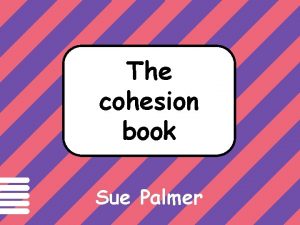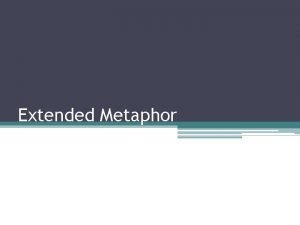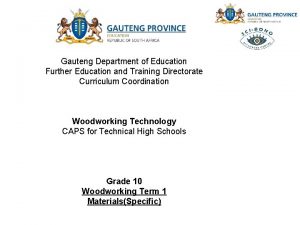Gauteng Department of Education Further Education and Training















- Slides: 15

Gauteng Department of Education Further Education and Training Directorate Curriculum Coordination Woodworking Technology CAPS for Technical High Schools Grade 10 Woodworking Term 1 Materials(Generic)

LESSON PLAN 19 TABLE OF CONTENT 1. Metal: Ferrous metals: 1. 1 Grey cast iron 1. 2 Ductile cast iron 1. 3 Wrought iron 1. 4 Malleable iron 1. 5 Low carbon steel 1. 6 Stainless steel 2. Non- ferrous metals : 2. 1 Aluminium 2. 2 Bronze 2. 3 Copper 2. 4 Lead 2. 5 Tin 2. 6 Zinc

1. Metal: Ferrous metals: 1. 1 Grey cast iron v Appearance: v Composition: v Properties: v Uses: Dark grey in colour, sandy surface showing casting line. Consists of a great deal of carbon (more than 2. 5%) Low melting point (approximately 150˚C) Contains manganese, phosphorus, silicone, and sulphur. Carbon content between 1, 5% and 4. 5%. Very hard, brittle, casts easily, extremely hard wearing. Baths, wash basins, drain pipes, manhole covers. Marking out tables and surface plates. Vice bodies, lathe face plates and chuck bodies. Cylinder blocks, piston rings.

1. 2 Ductile cast iron v Appearance: A type of cast iron, grey in colour. v Composition: Elements such as copper or tin may be added to increase tensile and yield strength while simultaneously reducing ductility. Improved corrosion resistance can be achieved by replacing 15% to 30% of the iron in the alloy with varying amounts of nickel, copper, or chromium.

v Properties: While most varieties of cast iron are brittle, ductile iron has much more impact and fatigue resistance, due to its nodular graphite inclusions. v Uses: Much of the annual production of ductile iron is in the form of ductile iron pipe, used for water and sewer lines. It competes with polymeric materials such as PVC, HDPE, LDPE and polypropylene, which are all much lighter than steel or ductile iron; being more flexible, these require protection from physical damage.

1. 3 Wrought iron v Appearance: Black/grey in colour. v Composition: This soft metal has a small amount of other elements added to it making it a useful and durable. 99% iron with slight impurities. ( iron silicate) v Properties: It can be made malleable and ductile with a high tensile strength. Quickly recovers from overstrain. v Uses: It is too soft to have any practical use, but are used as haulage gear, anchor chains, crane hooks, boiler plates.

1. 4 Malleable iron v Appearance: v Composition: v Properties: v Uses: Black/grey in colour Contains similar elements to cast iron but in different quantities. The strength and ductility of this metal results from the long and carefully regulated heat treatment it is given. It is used for threaded fittings for steel pipe. 1. 5 Low carbon steel (mild steel) v Appearance: v Composition: v Properties: v Uses: Fine, smooth surface with a bluish sheen. An alloy of iron and carbon. Carbon content up to 0, 35%. Malleable, ductile and very uniform in texture. Forgeable, Flexible (bendable), rust easily. Rolled profile steel sections. Sheet metal, bolts and nuts, rivets, nails, reinforcing.

1. 6 Stainless steel v Appearance: It is bright silver in colour. v Composition: There are various types of stainless steel available but the one that contains both chromium and nickel is the most popular. v Properties: Durable, resistant to corrosion but difficult to bend. Most fittings used for copper pipe are suitable for stainless steel although compression fittings are easier and preferable. A special flux is needed if capillary joints are to be used. v Uses: Pipes and sanitary appliances for public buildings.

2. Non- ferrous metals : 2. 1 Aluminium (Al) v Appearance: v Composition: v Properties: v Uses: Very light in weight, malleable, soft, ductile and a good conductor of electricity. Reasonably low melting point. It is somewhat affected by the atmosphere, but with exposure it is covered with a thin layer of zinc oxide, which, due to insolubility thereof, gives protection against further reaction.

2. 2 Bronze v Appearance: v Composition: v Properties: v. Uses: Varies between dull gold and yellow in colour depending on the amount of zinc. Bronze is an alloy of copper. The commonest bronze used in plumbing is known as gunmetal and contains 88% copper, 10% tin and 2% zinc. Commercial bronze (90% copper and 10% zinc) and architectural bronze (57% copper, 3% lead, 40% zinc) are more properly regarded as brass alloys because they contain zinc as the main alloying ingredient. They are commonly used in architectural applications. It is a strong ductile metal which is manufactured as pipe and sheet. Its main uses in plumbing are the same as for brass, manufactured for pipe fittings and valves.

2. 3 Copper (Cu) v Appearance: v Composition: v Properties: v Uses: Reddish brown or salmon pink – a colour that darkens if exposed. Most copper is mined or extracted as copper sulphides from large open pit mines in porphyry copper deposits that contain 0. 4 to 1. 0% copper. Very malleable and ductile. Excellent conductor of heat and electricity, hence its used for soldering bite, electric wire. Non magnetic, resistant to corrosion, expensive but durable. It is used as a conductor of heat and electricity, a building material, and a constituent of various metal alloys, electric conductors, water pipes, heads of soldering irons.

2. 4 Lead (Pb) v Appearance: v Composition: v Properties: acids. Very v Uses: Blue grey in colour. Lead is usually found in ore with zinc, silver and (most abundantly) copper, and is extracted together with these metals. The main lead mineral is galena (Pb. S), which contains 86. 6% lead by weight. Other common varieties are cerussite (Pb. CO 3) and anglesite (Pb. SO 4). [19 Very soft and malleable. Reasonably low melting point and flexible. Very high extension and shrinkage. Not effected by water and heavy. Solder (an alloy of tin and lead) Lead is used in building construction, lead-acid batteries, bullets and shot, weights, as part of solders, pewter, fusible alloys, and as a radiation shield.

2. 5 Tin (Sn) v Appearance: The colour has a white or silvery tint with a yellow shine. v Composition: Tin does not occur as the native element but must be extracted from various ores. Cassiterite (Sn. O 2) is the only commercially important source of tin, although small quantities of tin are recovered from complex sulfides such as stannite, cylindrite, franckeite, canfieldite, and teallite. Minerals with tin are almost always associated with granite rock, usually at a level of 1% tin oxide content.

v Properties: Soft, malleable and fairly ductile. Keeps its lustre and has a high corrosion resistance. Tin resists corrosion from water, but can be attacked by acids and alkalis. Tin can be highly polished and is used as a protective coat for other metals v Uses: As an alloy material. Covering of iron and steel (tin plate)

2. 6 Zinc (Zn) v Appearance: v Composition: v Properties: v Uses: Bluish grey white. Almost the only metal with “grain”. The most common zinc ore is sphalerite (zinc blende), a zinc sulfide mineral. Zinc is a chalcophile, meaning the element has a low affinity for oxides and prefers to bond with sulphides. Very light in weight, malleable, soft, ductile and a good conductor of electricity. Reasonably low melting point. It is somewhat affected by the atmosphere, but with exposure it is covered with a thin layer of zinc oxide, which, due to insolubility thereof, gives protection against further reaction. As an alloy metal. Covering of iron for exterior use (galvanised steel)
 10 pillars of gauteng department of education
10 pillars of gauteng department of education Gde mission and vision
Gde mission and vision 10 pillars of education in gauteng
10 pillars of education in gauteng Havering college of further and higher education
Havering college of further and higher education Department of higher education and training
Department of higher education and training Further education support service
Further education support service Webdhis 2 eastern cape
Webdhis 2 eastern cape Nsla in education
Nsla in education Sapa gauteng
Sapa gauteng Gauteng rapid land release programme
Gauteng rapid land release programme Cohesion
Cohesion Tension in elastic string
Tension in elastic string Life is a highway metaphor
Life is a highway metaphor Simplification of force and moment system
Simplification of force and moment system Further mechanics 1 unit test 1 momentum and impulse
Further mechanics 1 unit test 1 momentum and impulse Department of labor and training
Department of labor and training





























